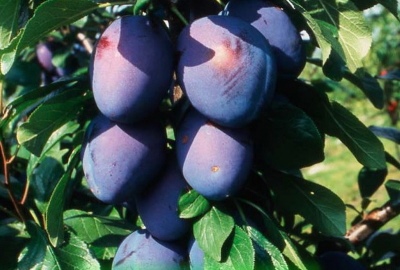
- Authors: Polish-American selection, USA
- Appeared when crossing: Standard x Stanley
- Name synonyms: Amers
- Growth type: medium-sized
- Crown: sparse
- Fruit size: large
- Fruit weight, g: 50-60
- Fruit shape: oval, slightly flattened
- Fruit color: violet-bluish or burgundy-bluish
- Skin : with a slight waxy bloom
When choosing a plum tree for planting in the country, you should pay attention to varieties that bring bountiful harvests, without requiring complex agricultural technology instead. These are the mid-late plum Amers of Polish-American selection.
Breeding history
Plum Amers was obtained thanks to the efforts of a group of Polish and American breeders. A variety was created by crossing two species - Standard and Stanley. The tree is unpretentious and can grow productively in any climatic zone.
Description of the variety
Amers is a medium-sized tree with a rounded-raised crown shape. It is characterized by moderate thickening of light green foliage, developed root system and medium branching. Flowering occurs in the mid-early period. During this period, the crown is simply covered with light flowers, which bring a pleasant aroma.
Fruit characteristics
Plums of Polish-American selection belong to the class of large-fruited crops with a mass of 50-60 grams. The shape of the fruit is correct - oval, slightly flattened. Ripe plums have a bright and beautiful color - depending on weather conditions, the degree of illumination and the characteristics of the region, the fruits acquire a violet-bluish or burgundy-blue color. The plum peel is moderately dense, smooth, with a pronounced waxy bloom. The plum stone is small, easily separating from the pulp.
The purpose is universal - the plum is eaten fresh, used in cooking, canned, processed into jams, preserves, compotes. In addition, it is ideal for freezing, and prunes are made from it. A pleasant feature of the variety is its transportability and long shelf life - up to 3-4 weeks.
Taste qualities
The fruit tastes excellent. The pulp is similar in consistency to an apricot. It is dense, fleshy, with a characteristic amber or orange-yellow color. The taste harmoniously combines both sweetness and sourness, complemented by a dessert aroma. The juiciness of the pulp is moderate, and the rind is not felt at all when eaten.
Ripening and fruiting
Plum Amers is a tasty representative of mid-late varieties. The first harvest is observed in the 2-3rd year after planting. The tree bears fruit regularly, without gaps. You can taste the first fruits from the end of August, and the peak of fruiting occurs in mid-September. The fruits are spiced together. In order for the crop to be stored for a long time, plums must be removed at the stage of technical maturity.

Yield
Plum yields are quite high. The fruits are harvested in several stages. With proper care and favorable conditions, 20-30 kg of delicious plums can be harvested from 1 tree.
Self-fertility and the need for pollinators
The variety is partially self-fertile, so donor trees planted on the site will certainly be needed. Pollinating trees should bloom at the same time as the Amers plum.The best pollinating varieties are: Stanley, Empress, Bluefri and Niyboliya, President and Vengerka Dabrovskaya.
Growing and care
The Polish-American plum Amers does not require too complicated agricultural technology, but the culture is a little capricious to the place of growth and soil. It is better to plant a seedling in a place well lit by the sun with a deep passage of groundwater. The soil should be fertile, breathable, moisture-permeable, with neutral or low acidity.
The seedling is planted in early spring (before the beginning of the growing season) or in the fall (a month before stable frosts). Plum tree agrotechnology consists of: regular watering, top dressing, loosening, weeding, sanitary pruning of branches, crown formation, mulching of the near-stem zone and protection from pests and diseases. In addition, do not forget about regular thinning of the crown, since foliage and branches grow very quickly. It is the abundance of light that has a positive effect on the quality of the fruit and the quantity of the harvest.




Disease and pest resistance
The fruit crop has good immunity, therefore, the plum is absolutely resistant to scab. In addition, the tree tolerates most of the fungal diseases that plum trees are susceptible to. The only thing the variety is susceptible to is moniliosis.

Despite the fact that plum is considered more hardy than many fruit trees, it is not immune from diseases. It is attacked by viral, fungal and bacterial infections, and parasitic insects harm it. It is necessary to notice and recognize the signs of plum disease in time. They are easier to deal with and defeat early on. Well, in order to protect the garden tree from such a misfortune in the future, preventive procedures can be carried out.
Resistance to soil and climatic conditions
Plum is endowed with excellent stress resistance, thanks to which it easily survives temperature drops, strong drops in temperature (frost resistance), heat and short drought. The culture is susceptible to drafts, strong winds and excessive soil moisture.

Review overview
Amers plum species has long been in high demand among amateur summer residents and farmers growing fruits on an industrial scale. This is due to the fact that the variety is cold-resistant, quickly gets used to its habitat, is rarely exposed to fungal diseases and bears fruit stably. In addition, plums have a universal purpose, which bribes housewives.
Of the shortcomings, gardeners point to the need for frequent thinning of the crown, as well as shedding of fruits.


































































